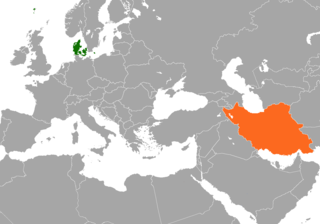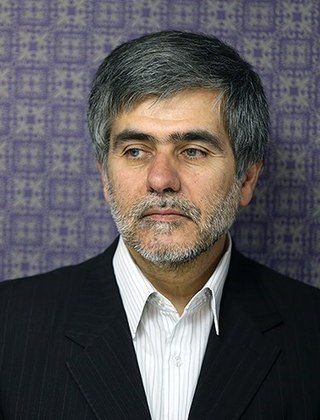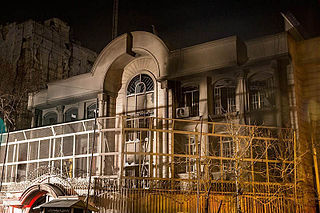Related Research Articles

The Iran hostage crisis was a diplomatic standoff between Iran and the United States. Fifty-three American diplomats and citizens were held hostage after a group of militarized Iranian college students belonging to the Muslim Student Followers of the Imam's Line, who supported the Iranian Revolution, including Hossein Dehghan, Mohammad Ali Jafari and Mohammad Bagheri, took over the U.S. Embassy in Tehran and took them as hostages. The hostages were held for 444 days, from November 4, 1979 to their release on January 20, 1981. The crisis is considered a pivotal episode in the history of Iran–United States relations.

The first Persian envoy to Denmark arrived in 1691 in order to negotiate the release of the Iranian-owned cargo of a Bengali ship seized by the Danish fleet. The Iranian diplomat had been issued with diplomatic credentials by Suleiman I of Persia and opened negotiations with King Christian V of Denmark. He was unable to secure the release of the cargo.
The Iran–Pakistan gas pipeline, also known as the Peace pipeline, or IP Gas, is an under-construction 2,775-kilometre (1,724 mi) pipeline to deliver natural gas from Iran to Pakistan.

Iran and Pakistan established relations on 14 August 1947, the day of the independence of Pakistan, when Iran became the first country to recognize Pakistan. Both sides continue to cooperate economically where possible and have formed alliances in a number of areas of mutual interest, such as fighting the drug trade along their border and combating the insurgency in the Balochistan region.

Beginning at 12:00 p.m. on 21 November 1979, a large mob of Pakistani citizens violently stormed the Embassy of the United States in Islamabad and subsequently burned it down in a coordinated attack. The riot was led by local Islamists aligned with the right-wing Pakistani political party Jamaat-i-Islami, and the mob primarily comprised students from Quaid-i-Azam University. Lasting for almost 24 hours, the riot had been incited by Iranian religious cleric Ruhollah Khomeini, who was leading the Islamic Revolution at the time, after he falsely claimed in a widespread Iranian radio broadcast that the then-ongoing Grand Mosque seizure in Saudi Arabia had been orchestrated by the United States and Israel, prompting many anti-American riots throughout the Muslim world. During the attack, the Pakistani rioters took several American diplomats as hostages with the intent of carrying out sham trials and public executions. In addition to Islamabad, there were similarly large riots in Karachi, Lahore, and Rawalpindi, where a number of American cultural centres were attacked and burned down.

Ali Akbar Mohtashamipur, also known as Mohtashami, was an Iranian Shia cleric and former interior minister of the Islamic Republic of Iran. He was active in the Iranian Revolution and is seen as a founder of the Hezbollah movement in Lebanon as well as one of the "radical elements advocating the export of the revolution," in the Iranian clerical hierarchy.
Since the Iranian Revolution in 1979, the government of the Islamic Republic of Iran has been accused by several countries of training, financing, and providing weapons and safe havens for non-state militant actors, such as Hezbollah in Lebanon, Hamas in Gaza, and other Palestinian groups such as the Islamic Jihad (IJ) and the Popular Front for the Liberation of Palestine (PFLP). These groups are designated terrorist groups by a number of countries and international bodies such as the EU, UN, and NATO; however, Iran considers such groups to be "national liberation movements" with a right to self-defense against Israeli military occupation. These proxies are used by Iran across the Middle East and Europe to foment instability, expand the scope of the Islamic Revolution, and carry out terrorist attacks against Western targets in the regions. Its special operations unit, the Quds Force, is known to provide arms, training, and financial support to militias and political movements across the Middle East, including Bahrain, Iraq, Lebanon, Palestine, Syria, and Yemen.
The Lars Vilks Muhammad drawings controversy began in July 2007 with a series of drawings by Swedish artist Lars Vilks that depicted the Islamic prophet Muhammad as a roundabout dog. Several art galleries in Sweden declined to show the drawings, citing security concerns and fear of violence. The controversy gained international attention after the Örebro-based regional newspaper Nerikes Allehanda published one of the drawings on 18 August as part of an editorial on self-censorship and freedom of religion.

Hamza bin Osama bin Mohammed bin Awad bin Laden, better known as Hamza bin Laden, was a Saudi Arabian-born member of al-Qaeda. He was a son of al-Qaeda leader Osama bin Laden, and, following his father's death in 2011, he was described as an emerging leader of the al-Qaeda organization.

The 2008 Indian embassy bombing in Kabul was a suicide bomb terror attack on the Indian embassy in Kabul, Afghanistan on 7 July 2008 at 8:30 AM local time. The bombing killed 58 people and wounded 141. The suicide car bombing took place near the gates of the embassy during morning hours when officials enter the embassy.

Canada and Iran have had no formal diplomatic relations since 2012. In the absence of diplomatic representation, Italy acts as the protecting power for Canada in Iran and Switzerland acts as Iran's protecting power in Canada.

Fereydoon Abbasi-Davani is an Iranian nuclear scientist who was head of the Atomic Energy Organization from 2011 to 2013. He survived an assassination attempt in 2010, but was wounded. He is a conservative and principlist politician.

The 2011 attack on the British Embassy in Iran was a mob action on 29 November 2011 by a crowd of Iranian protesters who stormed the embassy and another British diplomatic compound in Tehran, Iran, ransacking offices and stealing documents. One small building was set on fire during the incident and several people were injured. The Iranian government publicly condemned the violence.

The Embassy of the United Kingdom in Tehran is the United Kingdom's diplomatic mission to the Islamic Republic of Iran. It is located at 172 Ferdowsi Avenue in Tehran.

Kenneth L. Kraus is a former United States Marine who was the first American taken hostage by Iranian militants prior to the Iran hostage crisis.

Jaish ul-Adl, or Jaish al-Adl, is a Baloch Sunni Salafi Jihadist separatist organization that operates mainly in the Sistan and Baluchestan province in Iran, where there is a substantial Baloch population and a porous border with Pakistan.

The 2016 attack on the Saudi diplomatic missions in Iran was a mob action on 2 January 2016 by protesters against the execution of a prominent Saudi Arabian Shi'a cleric. Mobs stormed the embassy in Tehran and the Saudi consulate in Mashhad and ransacked them. The embassy building was set on fire with Molotov cocktails and petrol bombs. During the attacks, the police arrived and dispersed protesters from the embassy premises and extinguished the fire.
Between 2010 and 2020, five Iranian nuclear scientists were killed in foreign-linked assassinations. Rezaeinejad was shot dead by gunmen on motorcycles, while Shahriari and Ahmadi Roshan were killed by explosives attached to their cars. Fereydoon Abbasi was also targeted in a car bombing, but survived.

The 2017 Tehran attacks were a series of two simultaneous terrorist attacks that occurred on 7 June 2017 that were carried out by five terrorists belonging to the Islamic State of Iraq and the Levant (ISIL) against the Iranian Parliament building and the Mausoleum of Ruhollah Khomeini, both in Tehran, Iran, leaving 17 civilians dead and 43 wounded. The shootings were the first terrorist attacks in Tehran in more than a decade, and the first major terror attack in the country since the 2010 Zahedan bombings.
Events in the year 2023 in Iran.
References
- 1 2 APP (12 May 2010). "Pakistan ambassador to Tehran survives attack". TEX, 12 May 2010. Retrieved 9 August 2013.
- ↑ APP (11 May 2010). "Attack on Pakistani Ambassador in Iran". TEX, 2010. Retrieved 9 August 2013.
- ↑ 2009 attack on Pakistan Embassy in Tehran
- ↑ Staff desk (11 May 2010). "Pakistan ambassador in Tehran attacked". Reuters . Retrieved 9 August 2013.
- 1 2 "Ambassador leaves Tehran hospital in good health". Express Tribune. Retrieved 9 August 2013.